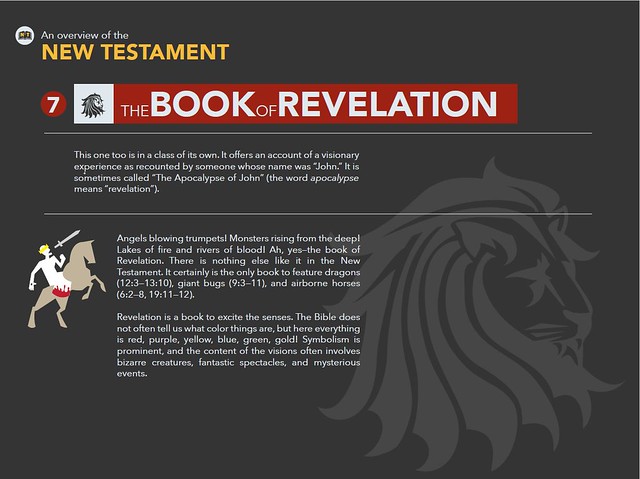Introducing the New Testament, 2nd Edition
A Historical, Literary, and Theological Survey
30. Revelation
Video Introduction
Summary
The chapter begins with an overview of the content of the book of Revelation. Then, it considers the question of genre and of how the book is read in Christian circles before moving on to discussion of historical background for the book and its major themes.
Revelation is a book that combines elements of three genres: letter, prophecy, and apocalypse. The last of these is a foreign genre to most modern readers but was common in the ancient world; familiarity with its key features aids in understanding Revelation the way it would have been read at the time of its composition.
In fact, Revelation has been read in three different ways throughout Christian history: as a historical work that conveyed distinctive messages to people at the time of its writing, as an idealist or symbolic work replete with universal themes, and as a futurist writing that could only be understood at a time when its predictions began to be fulfilled. The latter approach is often pursued at a popular level, but academic scholars prefer idealist and, especially, historical readings.
In terms of historical background, Revelation is thought to have been produced by an otherwise unknown Christian named John (not to be confused with John the apostle) who was in exile on the island of Patmos. It was sent to seven churches in Asia Minor at a time when the Roman government was viewed as an especially hostile force, persecuting and murdering Christians. Scholars debate whether periods during the reign of Nero or Domitian provide the best backdrop for the book’s contents.
Revelation seeks to unveil the truth about God and the world. The Roman Empire, in particular, is exposed as a monstrous phenomenon, responsible for abominable injustice. It stands under the judgment of God, who controls the future and will act soon to rescue faithful believers from the forces of evil. Revelation depicts the ultimate victory of God as something that has already been assured and, indeed, accomplished through the death and resurrection of Jesus Christ. The book also presents God and Jesus Christ as the only ones worthy of worship and, in that vein, it is replete with liturgical material intended to aid the church in its worship life.
Study Questions
Describe the three genres of literature that contribute to the book of Revelation. List six features of “apocalypses” that would characterize Revelation.
Describe the three ways in which Revelation is often read within Christianity and provide two examples of how these “ways of reading” play out with regard to specific texts. Which ways of reading are preferred in academic scholarship?
Reflect on the sufferings of Christians that the book of Revelation may be intended to address: What sort of hardships and tribulations did Christians experience in Asia Minor at this time? How might theories regarding the date of this book’s composition affect your summation on this point?
What purpose does the book of Revelation state as the reason for its writing? List four ways in which it seeks to fulfill this purpose.
How is the image of the “whore of Babylon” intended to unveil the truth about Rome? Cite at least four ways in which this image applies to Rome.
How does the book of Revelation expect to inspire hope in its readers? In what way does its vision of the future claim to provide assurance that goes beyond mere wishful thinking?
Explore Readings
These readings provide a chance for you to explore the New Testament in more depth. The boxes from the text are included here, as well as bibliographies and outlines for the books of the New Testament.
All the Explore readings can also be downloaded as PDFs here.
30.14. The Date of Revelation: Clues within the Book Itself?
30.15. Church and State: Revelation as an Example of the Ethic of Resistance
30.17. Revelation 16:16—Where Is Armageddon? A Biblical Detective Story
30.20. Revelation 13:16–18—Who Might Bear the Number 666? (Box 30.3)
Interactive: Three Approaches to Revelation
Click to see different approaches to interpreting Revelation.
Assets
-
30.0. Revelation: Outline of ContentsDownload
-
30.1. Revelation in the Revised Common LectionaryDownload
-
30.2. Bibliography: RevelationDownload
-
30.3. Revelation and Other Johannine WritingsDownload
-
30.4. Symbolism in RevelationDownload
-
30.6. Prophetic Literature and Apocalyptic LiteratureDownload
-
30.7. Other ApocalypsesDownload
-
30.9. 2 Baruch--No Wine Shortage in the Age to ComeDownload
-
30.10. Revelation in the Christian CanonDownload
-
30.11. Authorship of RevelationDownload
-
30.12. Three Persons Named John?Download
-
30.13. Only One John: The Apostle Who Wrote Five BooksDownload
-
30.14. The Date of Revelation: Clues within the Book Itself?Download
-
30.15. Church and State: Revelation as an Example of the Ethic of ResistanceDownload
-
30.17. Revelation 16.16--Where Is Armageddon? A Biblical Detective StoryDownload
-
30.18. The "Book of Life" in Country MusicDownload
-
30.19. Revelation 4:15-16--In Praise of Lukewarm ReligionDownload
-
30.5. Some Common Features of Apocalypses (Box 30.1)Download
-
30.8. Gematria (Box 30.2)Download
-
30.16. Millennium, Tribulation, Rapture (Box 30.4)Download
-
30.20. Revelation 13:16-18--Who Might Bear the Number 666? (Box 30.3)Download
-
30.21. Revelation 14:19 and The Grapes of Wrath (Box 30.5)Download
-
Map 30.1. Asia Minor: Churches Addressed in RevelationDownload

